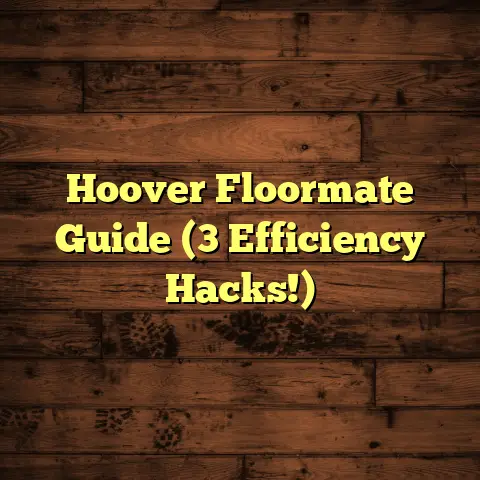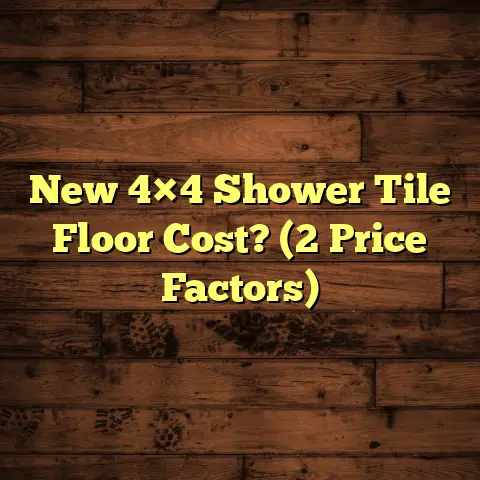Slippery Wood Floors? (10 Safety Fixes)
They’re stunning, durable, and a huge favorite these days, but let’s be real – they can be slippery!
I’ve seen firsthand how a gorgeous floor can become a hazard, especially for families with young kids or older adults.
Did you know that falls are a leading cause of injury? According to the National Safety Council, falls are a major concern, and home environments play a significant role.
While specific stats on wood floor-related falls are tricky to pin down, the general trend of increased fall-related injuries is something we need to address proactively.
That’s why I’m here to share my top 10 fixes to make your wood floors safer without sacrificing their beauty. Let’s dive in!
Section 1: Understanding the Causes
of Slippery Wood Floors
So, what makes those beautiful wood floors so darn slippery? It’s not just one thing, but a combination of factors.
First, let’s talk finish. That glossy, high-shine finish looks amazing, right? But it’s also the biggest culprit when it comes to slipperiness.
Think of it like ice – the smoother the surface, the less friction there is. Matte or satin finishes, on the other hand, offer a bit more texture and grip.
Then there are environmental factors. Humidity can play a huge role. When the air is humid, moisture can condense on the floor, creating a slick surface.
Spills, of course, are another obvious cause. Even a small amount of water or oil can turn your floor into an ice rink.
Wear and tear is another factor. Over time, the finish on your wood floors can wear down, becoming smoother and more slippery.
This is especially true in high-traffic areas like hallways and kitchens.
Finally, let’s consider the wood itself. Some wood species are naturally more slip-resistant than others. For instance, softer woods like pine tend to have a bit more give and texture compared to harder, denser woods like maple or Brazilian cherry.
Section 2: Assessing Your Space
Okay, now that we know what causes slippery floors, let’s figure out how to assess your own situation.
Start by walking around your house in your bare feet or socks. Do you feel any areas that are particularly slick?
Pay attention to high-traffic zones like hallways, entryways, and around furniture.
Consider rooms that are prone to moisture, like kitchens and bathrooms. These areas are naturally more susceptible to slipping hazards.
Here’s a little trick I like to call the “scoot test.” Put on your socks and try to gently scoot your feet across the floor. How easily do you slide?
If you can glide across the room with minimal effort, your floors are definitely too slippery.
You can also use slip-resistant mats in areas you suspect might be slippery to test the floor.
Section 3: Fix #1 – Use Area Rugs and Mats
This is probably the easiest and most effective fix. Area rugs and mats provide instant traction and can dramatically reduce the risk of slips and falls.
Think strategically about where you place them. High-traffic areas, entryways, and in front of sinks are all great spots for rugs.
When choosing rugs and mats, look for materials that offer good grip. Natural fibers like wool or cotton are generally better than synthetic materials.
Make sure the rugs are the right size for the space. You don’t want them to be too small, as this can actually create a trip hazard.
Also, consider using rug pads underneath your rugs to prevent them from sliding around. This is especially important on hardwood floors.
Section 4: Fix #2 – Choose the Right Cleaning Products
Believe it or not, some cleaning products can actually make your floors more slippery.
Products that leave behind a waxy or oily residue are the biggest offenders.
I always recommend using cleaning products that are specifically designed for hardwood floors. These products are typically pH-neutral and won’t damage the finish.
Avoid using harsh chemicals like bleach or ammonia, as these can strip the finish and make your floors more slippery over time.
When cleaning, use a microfiber mop and avoid over-wetting the floor. Too much water can seep into the wood and cause it to warp or swell.
One of my favorite cleaning solutions is a simple mixture of water and vinegar. It’s safe, effective, and won’t leave behind any residue.
Section 5: Fix #3 – Apply Non-Slip Treatments
There are a variety of non-slip coatings and treatments available on the market that can significantly improve the grip of your wood floors.
These treatments typically work by creating a textured surface that increases friction.
Before applying any treatment, make sure to thoroughly clean your floors and remove any dirt or debris.
Follow the manufacturer’s instructions carefully when applying the treatment. Some treatments require multiple coats or a specific drying time.
I usually recommend testing the treatment in an inconspicuous area first to make sure it doesn’t damage the finish.
Here’s a general step-by-step guide:
- Clean the floor: Use a hardwood floor cleaner to remove dirt and grime.
- Rinse: Ensure no cleaner residue remains.
- Apply the treatment: Use a mop or applicator pad to apply a thin, even coat.
- Dry: Allow the treatment to dry completely, following the product’s instructions.
- Test: After drying, test the area for improved grip.
Section 6: Fix #4 – Improve Footwear
The type of footwear you wear can make a big difference in terms of safety on wood floors.
Slippery socks or shoes with smooth soles are a recipe for disaster.
I always recommend wearing shoes or slippers with rubber soles that provide good grip.
Avoid walking around in your bare feet, especially if your floors are particularly slippery.
Consider investing in a pair of non-slip socks or slippers that are specifically designed for hardwood floors.
Section 7: Fix #5 – Install Anti-Slip Strips
Anti-slip strips are a great way to add traction to stairs and other high-risk areas.
These strips are typically made of rubber or textured plastic and have an adhesive backing that makes them easy to install.
When installing anti-slip strips, make sure to measure and cut them to the appropriate size.
Clean the surface thoroughly before applying the strips to ensure good adhesion.
Press the strips firmly into place and allow the adhesive to cure for the recommended amount of time.
Here’s how to install them:
- Measure: Determine the length needed for each step.
- Cut: Cut the strips to the measured length.
- Clean: Clean the stair surface thoroughly.
- Peel and Stick: Remove the adhesive backing and apply the strip.
- Press Firmly: Ensure the strip is securely attached.
Section 8: Fix #6 – Maintain Humidity Levels
As I mentioned earlier, humidity can make your wood floors more slippery.
Maintaining optimal humidity levels in your home can help prevent this issue.
The ideal humidity range for hardwood floors is between 30% and 50%.
Use a humidifier or dehumidifier to regulate the humidity in your home.
Monitor the humidity levels with a hygrometer to ensure they stay within the recommended range.
Proper ventilation can also help control humidity levels.
Section 9: Fix #7 – Regular Maintenance and Refinishing
Regular maintenance is key to keeping your wood floors safe and beautiful.
This includes sweeping or vacuuming regularly to remove dirt and debris.
Periodically refinishing your wood floors can also help maintain traction. Refinishing involves sanding down the old finish and applying a new one.
This process can create a more textured surface that provides better grip.
Refinishing can be a big job, but it’s well worth it in terms of safety and aesthetics.
Section 10: Fix #8 – Utilize Floor Buffing Techniques
Buffing can alter the surface texture of your wood flooring, making it less slippery. It’s like giving your floor a gentle exfoliation!
You’ll need a floor buffer, which you can rent from most hardware stores, and a buffing pad.
The key is to use a fine-grit buffing pad.
Coarse pads can damage the finish.
Here’s a basic rundown:
- Clean the Floor: Sweep or vacuum thoroughly.
- Attach the Pad: Secure the buffing pad to the buffer.
- Buff: Gently move the buffer in overlapping strokes.
- Vacuum Again: Remove any dust created by buffing.
Section 11: Fix #9 – Install Traction-Enhancing Accessories
There’s a whole world of accessories out there designed to enhance traction on slippery floors.
Think textured floor pads that you can place under furniture or adhesive grip strips that you can apply to specific areas.
These accessories are relatively inexpensive and easy to install.
Look for products that are specifically designed for hardwood floors.
You can find these accessories at most home improvement stores or online retailers.
Section 12: Fix #10 – Educate Household Members
Finally, and perhaps most importantly, educate everyone in your household about the risks associated with slippery floors.
Remind them to clean up spills immediately and to be mindful of floor conditions.
Encourage them to wear appropriate footwear and to walk carefully, especially in high-risk areas.
By creating a culture of safety at home, you can significantly reduce the risk of slips and falls.
Conclusion
So, there you have it – my top 10 fixes for slippery wood floors!
Remember, addressing this issue is not just about aesthetics; it’s about the safety and well-being of everyone in your home.
Take a proactive approach and implement these fixes to create a safer, more comfortable living environment.
I urge you to assess your current flooring situation and take the necessary steps to improve traction and reduce the risk of slips and falls.
Your family will thank you for it!





